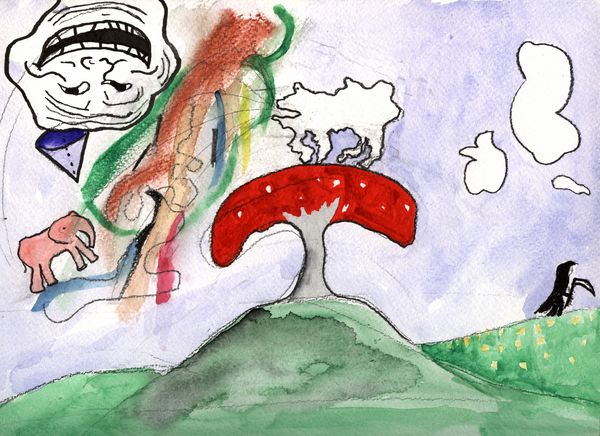Jussi Halla-aho, a Finnish politician, has recently become notorious in European newspapers for apparently denying that all humans have equal value. Particular attention has come from Austrian and German papers, which have a long-standing concern over such claims. The basis of this assessment is a blog post from 2005. In my opinion this attention has been a little unfair, and I recommend that any Finnish readers who are upset about it read the post for themselves as a philosophical musing rather than as ideological ground-preparation for the mass murder of artists, linguists and the unemployed. As far as I can see, non-Finnish speakers can’t read the blog post anywhere, so in service of anyone interested in the issue I have translated it below. My usual disclaimer: this isn’t a token of agreement or admiration, but of interest and a desire to allow people to understand one another.
On human value
An axiom is a claim with such self-evident verity that it requires no other justification. It must be axiomatic (pun intended) that particular care should be exercised in granting the status of axiom to any claim. Such a claim should preferably be true regardless of context, in place or time.
One contemporary axiom is the equality and universality of human value. Even the worst racist and antiegalitarian will generally attempt to include human equality into his theoretical framework. To deny the axiom is simply incorrect.
The claim that everyone has equal value requires that a person’s value is a known and measurable quantity. If it cannot be measured, there is no way to determine to what extent each individual is in possession of it. Certainly human value can’t be an externally given, cosmic property – or at least can’t be proven to be that. It isn’t inscribed in the stars, waters or bedrock. In fact there is no indication that the equality of human value, or indeed the entire concept of human value, is anything but an accepted convention, characteristic of our time, alongside the axioms of times past: “The Sun revolves around the Earth”, “The Pope is infallible”, “Women don’t have a soul”, “Masturbation causes shortsightedness”. The self-evidential quality of those has been as obvious as that of equality today. They have been supported by as little actual evidence as we have for equality of value. Because they haven’t lended themselves to supporting arguments, they have been declared axiomatic and therefore to require no support.
The only measurable and therefore definitely real human value is an individual’s instrumental value. Individuals can justifiably be hierarchically ordered by the extent to which the absence of their abilities and knowledge from a community would weaken it. The farmer, the man who raises animals for food and the building engineer are more valuable than others because without them the community would perish of famine and exposure. On the other hand, they would survive in the absence of everyone else’s abilities. The arms-bearing individual is next in value, because he protects the food stock and dwellings from wild beasts and enemies, and prevents the members of the community from destructively following their more primitive impulses.
The artisan (and his modern equivalent) is valuable in that his products and inventions improve the lives of everyone above and below himself in the hierarchy. The natural scientist (physicists and chemists in particular) is valuable because he produces information for the artisan, the soldier, the building engineer and farmer all to apply to their practical activities. It’s possible to survive without foundational science, but unpleasantly. The doctor is valuable because he extends life and improves its quality. He certainly isn’t completely indispensable, though; a great fraction of people would survive until their reproductive age without him. Procreation is the primary activity common to all species that everything else in service of.
The groups I have enumerated more or less produce, in the material sense, the society in which we live. These occupations permit a quantity of free time and the existential contemplation that follows from it, in which I include to a great extent astronomy and, to an even greater extent, the humanities. These things qualitatively separate us from apes, but are by no means necessary. Although it must be admitted that thanks to behavioural science we are perhaps less prone to killing one another. On the other hand, warfare improves group cohesion and almost always leads to technological breakthroughs.
Artists, the clergy and politicians are generally speaking superfluous. The community would function perfectly well without them, and their activities are made possible entirely by virtue of the efforts of other groups. Artists in particular are generally in the grip of a certain bitterness towards science, but no painting would be made without chemical industry, which is an application of natural science. The superfluity of these occupations to the rest of society is indicated, amongst other things, by the fact that they are mostly supported by public handouts from the rest of society.
When in the service of something non-critical, the value of intelligence is subjective, but I don’t think many would deny that reading a good book or hearing sense being spoken stimulates the mind and produces happiness. I find it a strange and insulting idea that Esko Valtaoja (SH: Finnish astronomer and writer) has no greater value than Juha Valjakkala (SH: Finnish murderer), Helena Lindgren (SH: Finnish celeb) or an immigrant loitering in the railway station.
Until someone demonstrates to me how everyone has equal value, I shall consequently consider difference of kind to lead to difference of value, and that everyone has a different amount of value. Unlike the egalitarians imagine, this doesn’t result in gassing those of lesser value in the absence of some particular reason. I value myself above a dead mouse lying on a forest path, but that doesn’t cause me to tear it into pieces. I think the world is a more pleasant place with art (not sure about religions and parliament) and linguistics. But if the boat starts leaking, I consider it obvious that the least valuable have to go first, ie. artists and linguists.
Egalitarian nonsense is the result of too many people with lots of energy and too little of consequence to do. As Finnish examples I might mention Karmela Liebkind (SH: academic, in the field of ethnic relations and social psychology) Rosa Meriläinen (SH: Finnish ex-politician, Green party) or Mikko Puumalainen (SH: minority ombudsman and chancellor of justice, pursued hate speech investigations). Like every age, ours is blind to the fact that we and our ideas are a momentary and soon to disappear eddy in the endless river of time. Generations to come will spit on our graves and receive our self-evidentialities with a hearty laugh and a wet fart. There is no reason not to believe that “equality”, “tolerance” and other things so important to us will be joining the long list of inanities of times past, alongside the Sun that revolves around the Earth, the Pope’s infallibility, the soullessness of women and the fact that masturbation causes shortsightedness.







